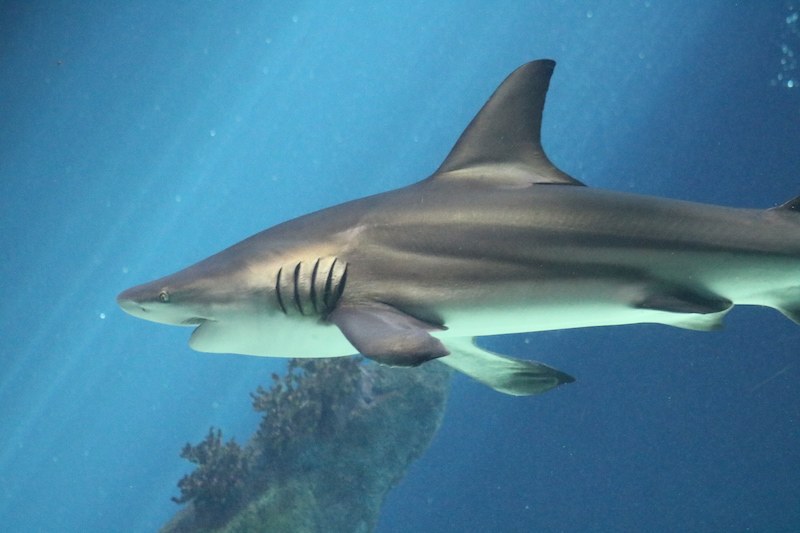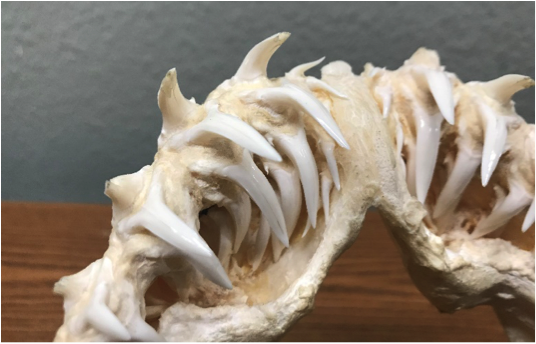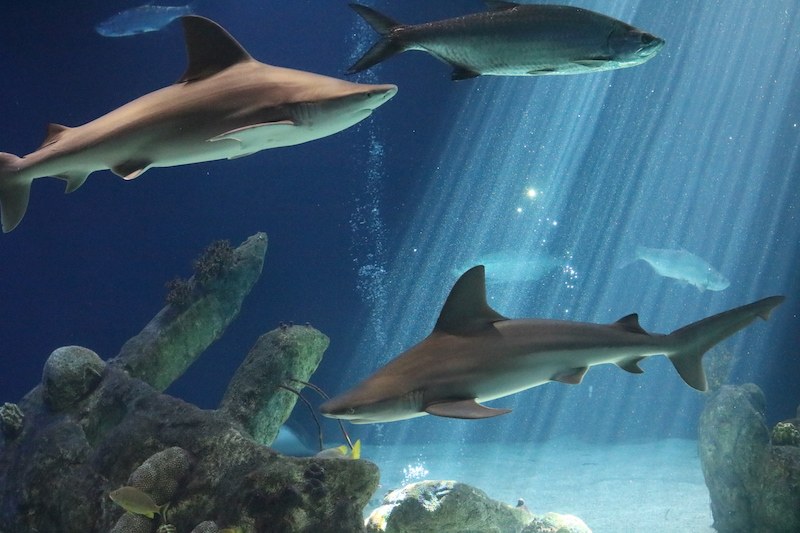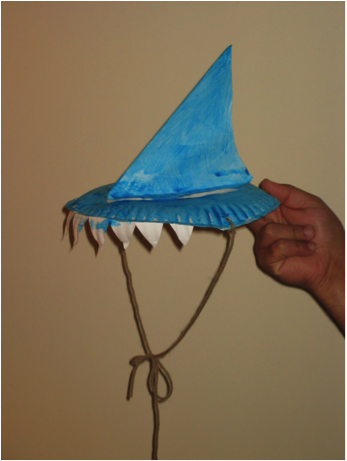Sharks
Connect with the sharks at the ABQ BioPark!
Learning Goal
Learn how AZA-accredited facilities like your ABQ BioPark are helping to save sharks.
Introduction: Sharks

Given their mysterious and frequently misrepresented habits, sharks have a troubled reputation. Sharks frequently fill a vital top-predator role in their ecosystem and pose very little actual threat to humans. Perhaps the most famous shark species is the white shark, or great white shark. The white shark prefers seals, sea lions, otters and other large marine mammals once they reach maturity. Humans tend to love the ocean where these prey species live. Shark attacks are generally cases of mistaken identity on the shark’s part. There are less than 100 unprovoked human-shark attacks in the world every year.
There are more than 500 species of sharks and scientists are still discovering more. They have been around a long time too; shark fossils have been dated back 400 million years! They’ve been around for so long because they have so many unique and successful adaptations. From prehistoric Megalodons to modern-day great white sharks, these animals share some common features that enable them to stay at the top of the food chain.
Sharks’ hydrodynamic (think aerodynamic but in the water) bodies and rigid fins allow them to make quick movements and swim with little effort. They have tapered bodies at both head and tail, which enables them to slice through the water with speed and efficiency, surprising their prey. Sharks also have cartilage, not bone; the same tissue in your ears and nose. Cartilage is light and flexible; well suited for a shark’s aquatic life. Sharks also have sharp scales, called dermal denticles, which allow them to move quickly through the water by reducing drag (a type of resistance that slows you down: think swimming with jeans and a sweatshirt on versus a swimsuit), protects them from being easily scratched and makes it more difficult for parasites to latch on.
All carnivores have different methods of obtaining prey. Imagine how a polar bear covered in fur moves through the water then think about how a shark does it. Both predators hunt aquatic prey but they do so with different strategies. A shark needs to be able to move quickly in the water while a polar bear needs to stay warm while out of the water waiting for the perfect opportunity to snag its prey.

Even thought they’re at the top of the food chain, sharks are not without problems. Like many other animals, sharks suffer from human-caused changes to their environments, negative stigma and illegal hunting, which has led to population declines globally. We can all do our part to learn about and protect sharks.
Sharks at the BioPark
More than 20 sharks, along with a variety of other fish, turtles, eels and rays, live in the ABQ BioPark Aquarium’s Open Ocean Tank. The sharks range in size, shape, age and sex. The distinctive sand tiger shark, boasting a mouth brimming with teeth, slowly cruises near the tank’s surface. You’ll usually find the tasseled wobbegong resting on the bottom of the tank (if you can spot her—she is camouflaged head to tail!). The two nurse sharks are usually resting on the sand along with the zebra shark, who is camouflaged in spots.
The BioPark Aquarium’s Mangrove touchpool exhibit allows guests a close and personal experience with two shark species: epaulette and white spotted bamboo sharks. The touchpool is large enough that the sharks and southern rays have the choice to get close to the edge for contact with guests. At the BioPark, we believe that up-close and personal encounters are key to inspiring a love for nature.
BioPark staff work tirelessly to make sure that the sharks and other animals in the Open Ocean and Mangrove tanks are healthy, well fed, and live in a clean environment. The residents of each exhibit are fed daily. During feedings, aquarists also monitor each animal for any issues. The sharks in the Open Ocean tank are fed from above the tank, individually, to make sure they are getting an amount of food that is healthy for them. This is accomplished through “target training” where the shark has to swim to a specific target or place to be fed. This training ensures the health and safety of all the sharks. It also reinforces to the sharks where their food is coming from through repetition. The aquarists also scuba dive to clean the tank and check up on each animal to make sure that there are no visible health or behavioral changes. During these daily dives, the rays and a few other specific fish are hand fed. This ensures that each animal is consuming an adequate amount of food and is willing to take medication when needed. Any medications are hidden in an animal’s favorite food item. Although sharks are adept hunters, they are generally shy around humans and keep their distance from our divers.
Read more about how BioPark staff take care of the resident sharks and how peaceful it is to be in the water with them.
Our Actions Matter

Scientists have identified more than 500 shark species, and according to the International Union for the Conservation of Nature (IUCN), 74 of those species are globally threatened. Another 26 species are endangered or critically endangered. Endangered—sand to a further extreme—critically endangered, means that the population of an animal species is so small that it is in danger of becoming extinct. The Association of Zoos and Aquariums (AZA) participates in research about sharks and conservation projects such as this one. Sharks and rays are also part of Species Survival Plans (SSPs) which collect standardized data about animals, and allow keepers to collaborate, share valuable information about species and obtain the highest genetic variations of each animal.
AZA-accredited facilities like the ABQ BioPark work to make sure that people understand the many issues that sharks face including overfishing, habitat loss, low prey populations and warming ocean waters. Over the last 100 years, shark populations have dramatically decreased.
Humans have depended on and utilized animals for as long as we have been on Earth. While many interactions with animals are positive, some are not. It is up to us to support healthy and constructive relationships with all creatures, large or small, slimy or fury, gooey or beautiful, peaceful or scary. Sharks are among the most fascinating aquatic animals because of all of their crafty adaptations and their variety of habitats. They are found across the seas from sunny tropical coral reefs to the dark depths near the bottom of the ocean.
How You Can Help Sharks
We can all help sharks with these simple steps:
- Reuse items instead of throwing them away, recycle when you can
- Reduce the amount of single use plastic used in the home – use a pitcher water filter and reusable water bottle instead of plastic bottles of water
- Reduce water usage at home (turn the faucet off while you brush your teeth) – helpful tips here
- Ask your parents to shop for sustainable seafood (usually marked on the package) - SeaFood Watch
- Refrain from purchasing items such as dried seahorses, shark jaws, seashells and other ocean items.
- Enlist your family members to avoid makeup products containing squalene – this is shark liver oil
- Ask your parents to reduce or eliminate the use of commercial fertilizer around the yard – these chemicals run off into the Rio Grande (eventually) causing harm to all the critters that live there
Humans are a far bigger threat to sharks than sharks are to humans. They can use all the help they can get. When you support your ABQ BioPark or other AZA-accredited facilities, you are helping to save sharks. Spread the word about sharks and their amazing abilities.
Activities
Browse through the various shark activities below and find one suitable for you.
Fantastic Fins Hat - Craft Activity

Materials
- Paper/cardboard
- Paper plate or bowl
- String/floss/rope
- Scissors
- Paint/markers/crayons
- Glue/tape
Directions
- First make the shark fin itself. Use scissors to cut out your own shark fin design out of paper or cardboard. Download and print a shark fin if you do not want to use your own design. The important part is that it is triangular; remember shark fins come in all shapes and sizes.
- After you have a good fin, use more paper/cardboard to cut out shark teeth in the form of half-inch to two-inch triangles. Eight to 12 teeth are good, although an actual shark would have hundreds! Cut out as many as you would like and place them to the side. Remember that most sharks keep growing and replacing their teeth all the time!
- After you have the shapes of your fin and teeth, get the paper plate or bowl you are also using as the base of your hat and color/paint everything. Get creative! Are you a tiger shark or a reef shark? Do you have stripes or spots? What color is your shark? You can add some color to your shark’s teeth or leave them white.
- Next use your scissors or a hole-punch to put two holes in your hat base on opposite sides. These are for you to attach the string in order to make your hat. Tie the string on one side and then measure around the head of your “shark” to make sure the string is the right length before tying the other side as well.
- The last step is to glue or tape the teeth along the front side of the hat and to glue/tape the shark fin on top.
Enjoy pretending to be a shark. Use your new fin to help swim through water and quickly maneuver to find prey. Shark fins are important for them to have as they need them to swim well, hunt and balance.
Challenge the Stigma - Art Project
Materials
Any materials you want including:
-
Paint
-
Sketching materials
-
Video/camera
-
Clay
-
Etc.
Directions
- Create a piece of shark art in a way that accurately shows off a shark’s adaptations like their amazing hunting abilities or teeth while not making them seem scarier or more threatening than they are.
- Consider: Sharks are often made out to be the “bad guy” in art, literature and movies. What can you do to combat this negative stereotype with your art?
- What conservation message do you want to portray with your art?
Additional Resources
- Find more educational shark activities including shark length graphing, anatomy, word-searches, coloring and more!
- Go to this live-cam to watch sharks and more at the Monterey Bay Aquarium.
- Read about IUCN Red listing of sharks, rays and chimeras.
